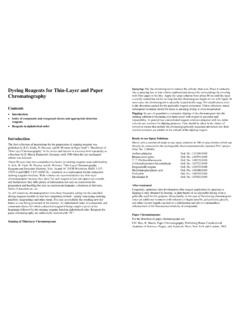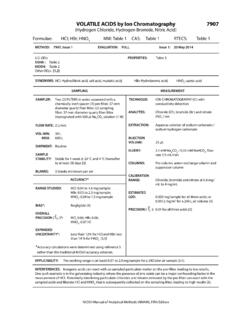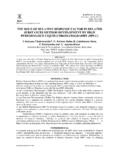Transcription of NMAM 7908: NON-VOLATILE ACIDS(Sulfuric acid and …
1 NIOSH Manual of Analytical Methods (NMAM), Fifth Edition NON-VOLATILE ACIDS (Sulfuric Acid and Phosphoric Acid) 7908 Formulae: H2SO4 MW: CAS: 7664-93-9 RTECS: WS5600000 H3PO4 MW: CAS: 7664-38-2 RTECS: TB6300000 METHOD: 7908, Issue 1 EVALUATION: FULL Issue 1: 10 May OELsOSHA : 1 mg/m3 (H2SO4 & H3PO4)NIOSH: 1 mg/m3 (H2SO4 STEL: 3 mg/m3 (H3PO4)OtherOELs: [1,2]PROPERTIES:H24 C (98%); 330 C (100%); VP = < kPa @ 20 CH3PO4: Solid (often used in an aqueous solution), mp = C; bp = 158 C; vp = kPa @ 20 CSO: Liquid, mp = C (98%); 10 C (100%); bp = 338 SYNONYMS: H2SO4: hydrogen sulfate, oil of vitriol; H3PO4: ortho-phosphoric acidSAMPLINGSAMPLER: FILTER, 37-mm diameter quartz fiber; or polytetrafluoroethylene (PTFE), m pore sizeFLOW RATE: 1 to 5 L/min VOL-MIN: 15 L -MAX: 2000 LSHIPMENT: 4 CSAMPLE STABILITY: Stable for 1 week at about 20 C and at 4 C thereafter to 28 days [3]BLANKS: 3 field blanks minimum per setACCURACY*RANGE STUDIED: to mg/sampleBIAS*: Negligible [3]OVERALLPRECISION (rT S)*: H2SO4 =.)
2 H3PO4 = *: less than 23% for both H2SO4 and H3PO4 [6]* Accuracy calculations were determined using references 5 and 6 rather than the traditional NIOSH accuracy : ION CHROMATOGRAPHY (IC) with conductivity detectionANALYTES: Sulfate (SO2-4) ion, phosphate (PO3-4) ionEXTRACTION: Aqueous solution of sodium carbonate / sodium hydrogen carbonateINJECTIONVOLUME: 50 LELUENT: mM Na2CO3 mM NaHCO3, flow rate mL/minCOLUMNS: Pre-column, anion-exchange column and suppressor column CALIBRATION RANGE: H2SO4; mg/L to 8 mg/L; H3PO4; mg/L to 8 mg/L [6]ESTIMATED LOD: H2SO4 = mg/m3; H PO = mg/m3 (1 m334 air volume)[6] PRECISION (S): Hr2SO4 = ; H3PO4 = [3,7]APPLICABILITY: The working range for H2SO4 is (at least) to mg/sample, for H3PO4 is to mg/sample for a 420 Liter air sample [3,6].
3 INTERFERENCES: Particulate salts of sulfate or phosphate will give a positive interference. OTHER METHODS: This procedure, which is consistent with ISO 21438-1 [6], replaces NIOSH 7903 [8] for the determina-tion of sulfuric and phosphoric acid in workplace air samples by IC. The main advantage of NIOSH method 7908 is that it can allow for the collection of the inhalable fraction of sulfuric and phosphoric acid aerosols by means of the pre-filter (housed within an optional inhalable sampler.)NIOSH Manual of Analytical Methods (NMAM), Fifth EditionNON-VOLATILE ACIDS (Sulfuric Acid and Phosphoric Acid): METHOD 7908, Issue 1, dated 20 May 2014 - Page 2 of 5 REAGENTS:1.
4 Water, deionized (DI), 18 M -cm resistivity2. Sodium carbonate (Na2CO3), anhydrous, American Chemical Society (ACS) analytical grade3. Sodium hydrogen carbonate (NaHCO3), ACS analytical grade4. Extraction & eluent stock solution: M Na2CO3 / M NaHCO3; dissolve g Na2CO3 and g NaHCO3 in 25 mL of deionized water and swirl to mix. Then bring to 100 mL in a volumetric flask, stopper and mix Extraction & eluent solution: M Na2CO3 / M NaHCO3; transfer 10 mL of M Na2CO3 / M NaHCO3 stock solution to a 1 L volumetric flask, dilute to the mark with deionized water, stopper and mix Sulfate (SO42-) ion and phosphate (PO43-) ion standard solutions, each 1000 mg/L7.
5 Calibration stock solution, 100 mg/L (as the anion): Place 10 mL aliquots of sulfate and phosphate standard solution into a 100 mL volumetric flask, dilute to the mark and mix thoroughly.*See Special PrecautionsEQUIPMENT: 1. Sampler: filter, 37-mm diameter quartz fiber; or polytetrafluoroethylene (PTFE), m pore size, in cassette filter holder manufactured from acid-resistant (chemically inert) materialNOTE: Quartz fiber filters should be binderless and heat-treated. 2. Personal sampling pump, 1 to 5 L/min, with flexible connecting tubing3. Ion chromatograph, with pre-column (50 mm by mm), anion-exchange column (200 mm by mm), suppressor column (4 mm) and conductivity detector; and connected to data processing unit4.
6 Ultrasonic bath5. Vessels, 10-mL, plastic ( , polypropylene), with screw caps6. Volumetric flasks, 25- to 1000 mL7. Pipets, 50 to 10000 L8. Beakers, 25 to 100 mL9. Water purification system, to prepare greater than or equal to18 M -cm resistivity deionized water10. Bottles, polyethylene, 100 mL11. Syringes, plastic, 5 mL12. Syringe filter cartridges, with m pore size polytetrafluoroethylene (PTFE) membrane filters13. Micro-syringes, 50 L, with 60 mm x mm needles14. Tweezers, PTFE-coated15. Auto-sampler vials, 2 mL capacity16. Analytical balance, with capability of weighing to nearest mg SPECIAL PRECAUTIONS: Wear gloves, lab coat, and safety glasses while handling acids.
7 All work should be performed with adequate ventilation for personnel and equipment. It is imperative that acid be added to water in order to avoid a violent exothermic reaction. There is risk of fire and explosion when phosphoric acid has contact with bases, combustible substances, oxidizing agents, reducing agents or water. Avoid physical contact since both sulfuric and phosphoric acid are both corrosive and irritants to eyes, skin, and the respiratory system. These are caustic materials and can react with metals to form flammable hydrogen gas. Do NOT mix with solutions containing bleach or ammonia [9,10].SAMPLING, SAMPLE TRANSPORT AND STORAGE:1.
8 Calibrate each personal sampling pump with a representative sampler Sample at an accurately known flow rate between 1 and 5 L/min for a total sample size of 15 to 1000 Liters. Avoid sampler Immediately after sampling, remove the filter from the cassette with PTFE-coated tweezers and place it in a 10-mL screw-cap plastic vessel. With about 2 mL extraction NIOSH Manual of Analytical Methods (NMAM), Fifth EditionNON-VOLATILE ACIDS (Sulfuric Acid and Phosphoric Acid): METHOD 7908, Issue 1, dated 20 May 2014 - Page 3 of 5solution ( M Na2CO3 M NaHCO3), rinse material from the inside surfaces of the cassette into the vessel. Add additional extraction solution into the vessel until a final volume of 5 mL is Submit at least three field blanks for each set of samples collected per day.
9 Handle these in the same way as the field samples; , place each filter into a vessel, add 5 mL of eluent solution and ship it to the lab along with the remaining Refrigerate all samples that are to be stored overnight (or longer) prior to shipment to the laboratory. Ship all samples to the laboratory in accordance with established chain-of-custody procedures [11]. 6. Refrigerate the samples (4 C) immediately upon receipt at the lab until ready for analysis. 7. Analyze samples within 4 weeks of receipt. SAMPLE PREPARATION: 8. Remove sample vessels from storage and bring them to room Sonicate the samples in an ultrasonic bath for at least 15 minutes and allow to cool for at least 30 Using 5-mL syringes, filter each sample extract solution through a PTFE filter into clean plastic vessels or into autosampler vials (if autosampler used).
10 CALIBRATION AND QUALITY CONTROL: 11. Through dilution of the calibration stock solution in eluent solution, prepare calibration working standard solutions covering the range of approximately to 8 mg/L of sulfate and phosphate. Store working standards in tightly sealed polyethylene bottles. Prepare fresh working standards Calibrate the ion chromatograph with at least six working standards covering the range of to 8 mg/L of sulfate and phosphate ion per sample by preparing a calibration graph of anion peak height (mm or S [micro siemens]) vs. concentration (mg/L).13. Analyze working standards together with samples, reagent blanks and field blanks at a frequency of at least 1 per 20 samples (3 minimum of each).














